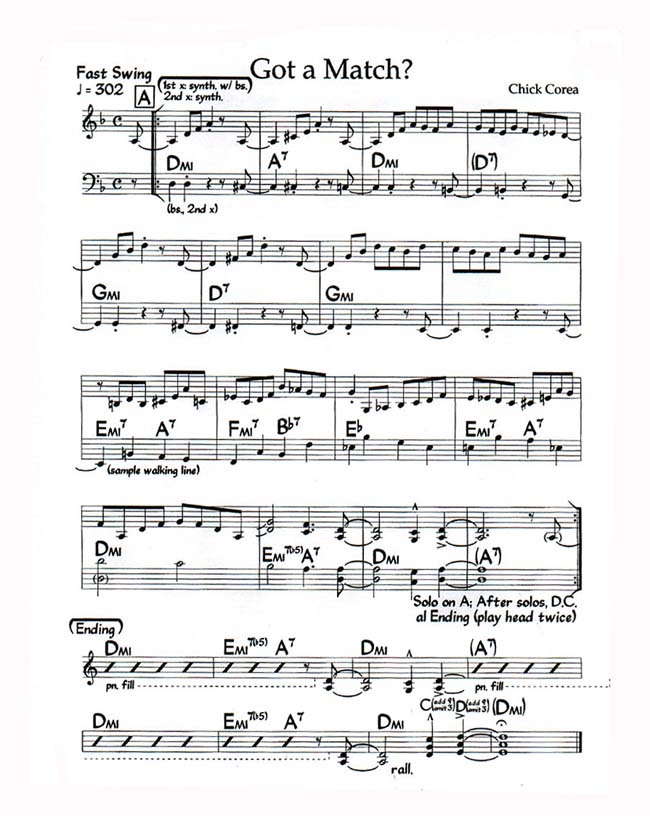

On their first two records, the group consisted of Flora Purim on vocals and percussion, Joe Farrell on flute and soprano saxophone, Miles Davis bandmate Airto on drums and percussion, and Stanley Clarke on acoustic double bass. Named after their eponymous 1972 album, Corea's Return to Forever band relied on both acoustic and electronic instrumentation and initially drew upon Latin American music styles more than rock music. I did not even think about a relationship to an audience, really, until way later. I grew up kind of only thinking how much fun it was to tinkle on the piano and not noticing that what I did had an effect on others. The reason I was using that concept so much at that point in my life – in 1968, 1969 or so – was because it was a discovery for me. The concept of communication with an audience became a big thing for me at the time. In 1971, Corea decided to work in a solo context, recording the sessions that became Piano Improvisations Vol. Aside from exploring an atonal style, Corea sometimes reached into the body of the piano and plucked the strings. They were active from 1970 to 1971, and recorded on Blue Note and ECM.
#Chick corea transcription pdf writer free#
Holland and Corea departed the Davis group at the same time to form their own free jazz group, Circle, also featuring multireedist Anthony Braxton and drummer Barry Altschul. His membership in the Davis band continued until 1970, with the final touring band he was part of consisting of saxophonist Steve Grossman, fellow pianist Keith Jarrett (here playing electric organ), bassist Dave Holland, percussionist Airto Moreira, drummer Jack DeJohnette, and, of course, Davis himself on trumpet. Utilizing this unique style, he appeared on multiple live Davis albums, including Black Beauty: Live at the Fillmore West, and Miles Davis at Fillmore: Live at the Fillmore East. In concert performances, he frequently processed the sound of his electric piano through a ring modulator. In 1968, Corea began recording and touring with Miles Davis, appearing on the widely praised Davis studio albums Filles de Kilimanjaro, In a Silent Way, Bitches Brew and On the Corner, as well as the later compilation albums Big Fun, Water Babies and Circle in the Round. Two years later he released a highly regarded trio album, Now He Sings, Now He Sobs, with drummer Roy Haynes and bassist Miroslav Vitous. He recorded his debut album, Tones for Joan's Bones, in 1966 (not released until 1968).
#Chick corea transcription pdf writer professional#
He quit both after finding them disappointing, but remained in New York.Ĭorea began his professional recording and touring career in the early 1960s with Mongo Santamaria, Willie Bobo, Blue Mitchell, Herbie Mann, and Stan Getz. He eventually moved to New York City, where he studied music at Columbia University, then transferred to the Juilliard School. He enjoyed listening to Herb Pomeroy's band at the time and had a trio that played Horace Silver's music at a local jazz club. Given a black tuxedo by his father, he started playing gigs while still in high school. Rose Scarlet Lancers, a drum and bugle corps based in Chelsea. He also spent several years as a performer and soloist in the St. A notable influence was concert pianist Salvatore Sullo, from whom Corea started taking lessons at age eight and who introduced him to classical music, helping spark his interest in musical composition.


When he was eight, he took up drums, which would influence his use of the piano as a percussion instrument.Ĭorea developed his piano skills by exploring music on his own. Surrounded by jazz, he was influenced at an early age by bebop and Dizzy Gillespie, Charlie Parker, Bud Powell, Horace Silver, and Lester Young. His father, a trumpeter who led a Dixieland band in Boston in the 1930s and 1940s, introduced him to the piano at the age of four. He was of southern Italian descent, his father having been born to an immigrant from Albi comune, in the Province of Catanzaro in the Calabria region. Armando Corea was born in Chelsea, Massachusetts, to parents Anna (née Zaccone) and Armando J.


 0 kommentar(er)
0 kommentar(er)
